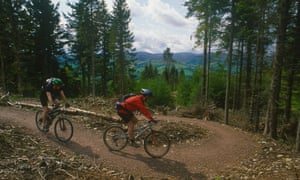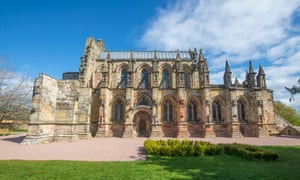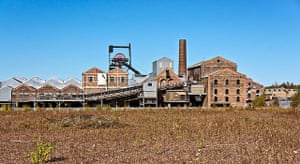
New train a comin’ … the new Borders Railway follows the old Waverley Line, running from Edinburgh to the new station of Tweedbank. Photograph: Peter Devlin
If you didn’t win a Willy Wonka-esque Golden Ticket in the recent competition, you won’t be aboard the first departure of the Borders Railway train on Saturday. Normal (paying) customers can travel on the longest new domestic line constructed in a century – from Sunday.
To celebrate the opening, three VIP trains will run on Saturday, between stations decked out with bunting, bands and marquees … A fair bit of fanfare, with the Queen officially opening the line on 9 September. The lucky passengers will be those who found a golden ticket inside special chocolate bars created by local chocolatier Cocoa Black.
The route follows the old Waverley Line, which once linked Edinburgh to Carlisle through the Scottish Borders, but was decommissioned in 1969 as a result of the 1963 Beeching Report. Now, for the first time in almost 50 years, rail passengers can explore this bucolic corner of southern Scotland by train on 30 miles of new track running from Edinburgh Waverley to a new station, Tweedbank, just outside Melrose. And there’s already talk about extending the line south to Hawick – famous for cashmere and tweed – and maybe as far as Carlisle. All the hype is aimed at making tourists rethink their plan of galloping north to the Highlands in search of the “real” Scotland.
From 10 September, and on Wednesdays, Thursdays and Sundays for the next six weeks, special steam trains will puff Hogwarts Express-style along the route. Tickets for these trips are already sold out, but fans can join a waiting list and get updates on the next journeys planned.
Alternatively, anyone will be able to climb aboard one of the slightly shabby ScotRail carriages – the project may have cost £350m but that didn’t stretch to new rolling stock – to ride the line that roughly follows the tortuous and notoriously slow A7. The journey takes just under an hour and stops at Newcraighall and Brunstane, and at new stations at Shawfair, Eskbank, Newtongrange, Gorebridge, Stow and Galashiels. More buses have been laid on from these stations to meet the expected extra demand, including a new Sunday service between Galashiels and the pretty little hamlet of St Boswells, and a new service between Galashiels and Jedburgh (with its abbey, Georgian jail and Mary Queen of Scots house).
Some attractions have really got behind the new line, offering a shuttle service from certain stations. Rosslyn Chapel – of Da Vinci Code fame – has pledged to meet each train and ferry visitors to the chapel from Eskbank station in a minibus.
The Borders landscape may be gently undulating, but its history is every bit as dramatic as that of the north. The border between England and Scotland has seen its share of bloody battles, and there are more impregnable-looking castles than you can toss a caber at – as well as Georgian gems that wouldn’t look out of place in a Jane Austen dramatisation. Architect Robert Adam completed honey-huedMellerstain House, and his father William designed grand Floors Castle.
The line brings 1,500 miles of walking trails within reach, from long-distance hikes such as the Southern Upland Way to shorter rambles and also cycling routes, including the 250-mile Borderloop. The area is also known for the spectacular ruins of four great 12th-century abbeys – Dryburgh, Melrose, Jedburgh and Kelso – now also linked by cycling and walking routes. The Borders Abbeys Way is a picture-postcard 64-mile walking route running through dappled woodland, along the banks of the salmon-rich Tweed and across gently rolling farmland, punctuated by the crumbling ecclesiastical ruins.
The historical highlights aren’t all so ancient, however. Newtongrange station, now just 20 minutes from Edinburgh, is connected by a walkway to the National Mining Museum. This is on the site of the 1890 Lady Victoria Colliery, with an impressive 500-metre shaft and a winding tower powered by Scotland’s largest steam engine.
From Gorebridge you’re handy for 14th-century Crichton Castle, while Stow is the hopping-off point for 16th-century Thirlestane Castle and is on the National Cycle Network. Speaking of cycling, the Tour of Britain will arrive in the Borders a few days after the railway opens, finishing stage three on 8 September in Kelso, with its huge cobbled square and abundance of fishing tackle shops.
The region is also a mountain-biking hot spot. From Galashiels it’s a half-hour bus ride to Innerleithen for some of Scotland’s best mountain biking, at the Glentress Forest centre, with trails for all grades. Galashiels is also close to Traquair House, one of the oldest stately homes in Scotland. Dating from 1107, it is charmingly ramshackle and has its own brewery.
The cafe at the new Galashiels station is a second outpost for Born in the Borders, a visitor centre, restaurant, shop and microbrewery in Lanton Mill, outside Jedburgh, that showcases the best local produce and crafts – with beers including Foxy Blonde, Holy Cow and Flower of Scotland, plus Wild Harvest, which is flavoured with foraged ingredients.
Melrose itself is the prettiest of the little Borders towns, with chic shops, cosy cafes and delis to mooch around. Its abbey ruins are rose-tinged – and Robert the Bruce’s heart is buried there.
The Buccleuch Arms in St Boswells won Scottish Inn of the Year 2015: it has antler chandeliers and signature steaks, from feather to thick rib. Round the corner, bookshop-cafe-deli the Main Street Trading Company is great for a rummage.
Walking distance from Tweedbank station is Abbotsford House, the home of Sir Walter Scott. It was Scott, ironically, who kickstarted tourism to the Highlands, changing the perception of a wild and dangerously unruly land to the romantic image of majestic mountains, tumbling burns, icy lochs and brooding castles.
The grand baronial mansion Scott designed has an armour-lined entrance hall, a library with 9,000 rare volumes, and an exhibition centre with a moving documentary. The novelist died here in 1832 and is buried in the most hauntingly beautiful of Borders abbeys, Dryburgh, among gnarled yews and cedars of Lebanon said to have been planted by Crusaders. It’s a fitting end to a trip on the revamped Waverley Line – named, of course, after Scott’s famous series of novels.
• Borders Railway day returns from Edinburgh cost from £3.70 (to Shawfair) to £11.20 (to Tweedbank). For steam train updates and tickets, visit Steam Dreams – first-class returns from Waverley to Tweedbank £75, standard-class £40, under-16s £20, family ticket £100 – the return leg is diesel-hauled. More information from scotrail.co.uk and bordersrailway.co.uk
By Lucy Gillmore, www.theguardian.com





No comments:
Post a Comment